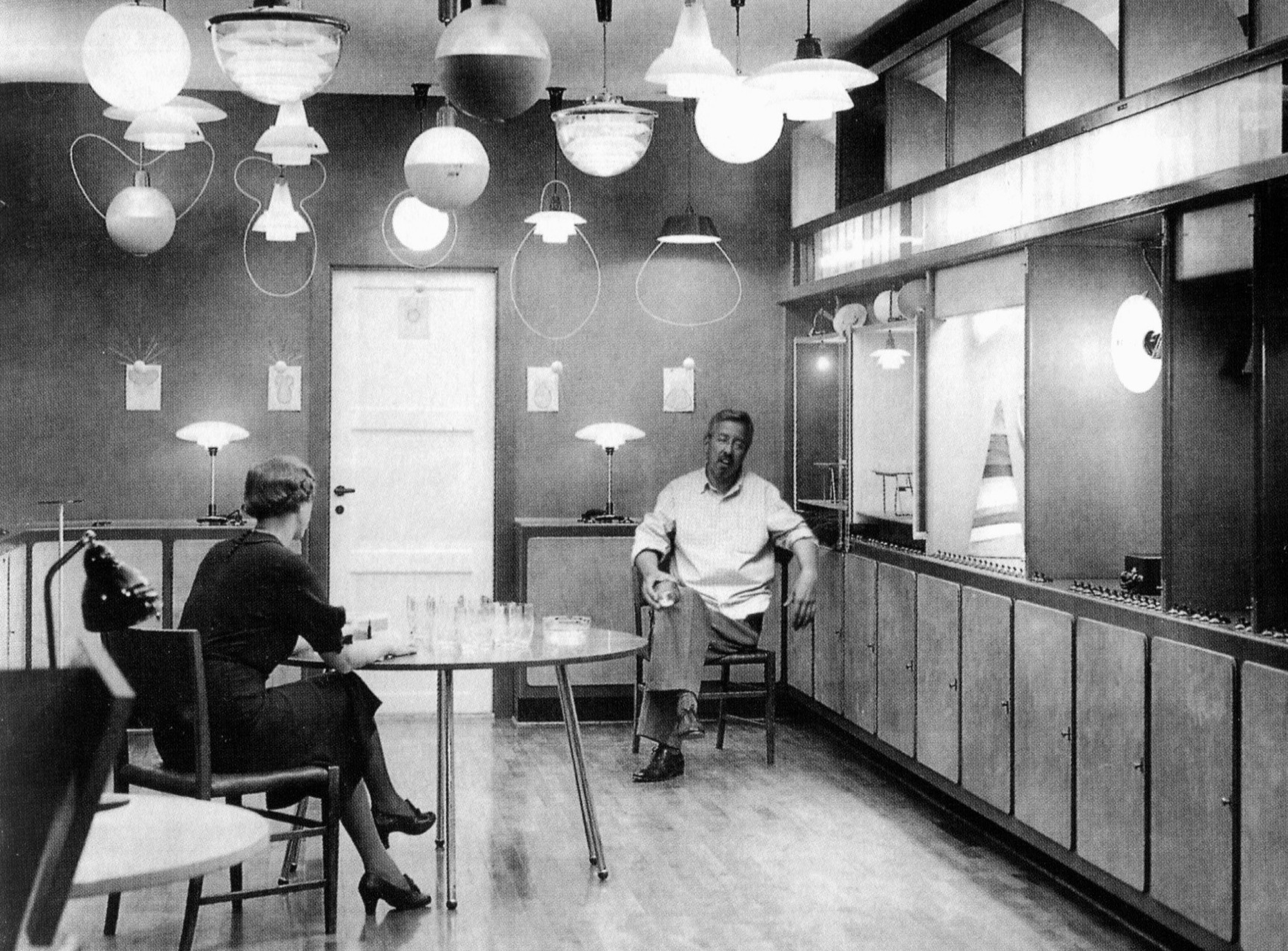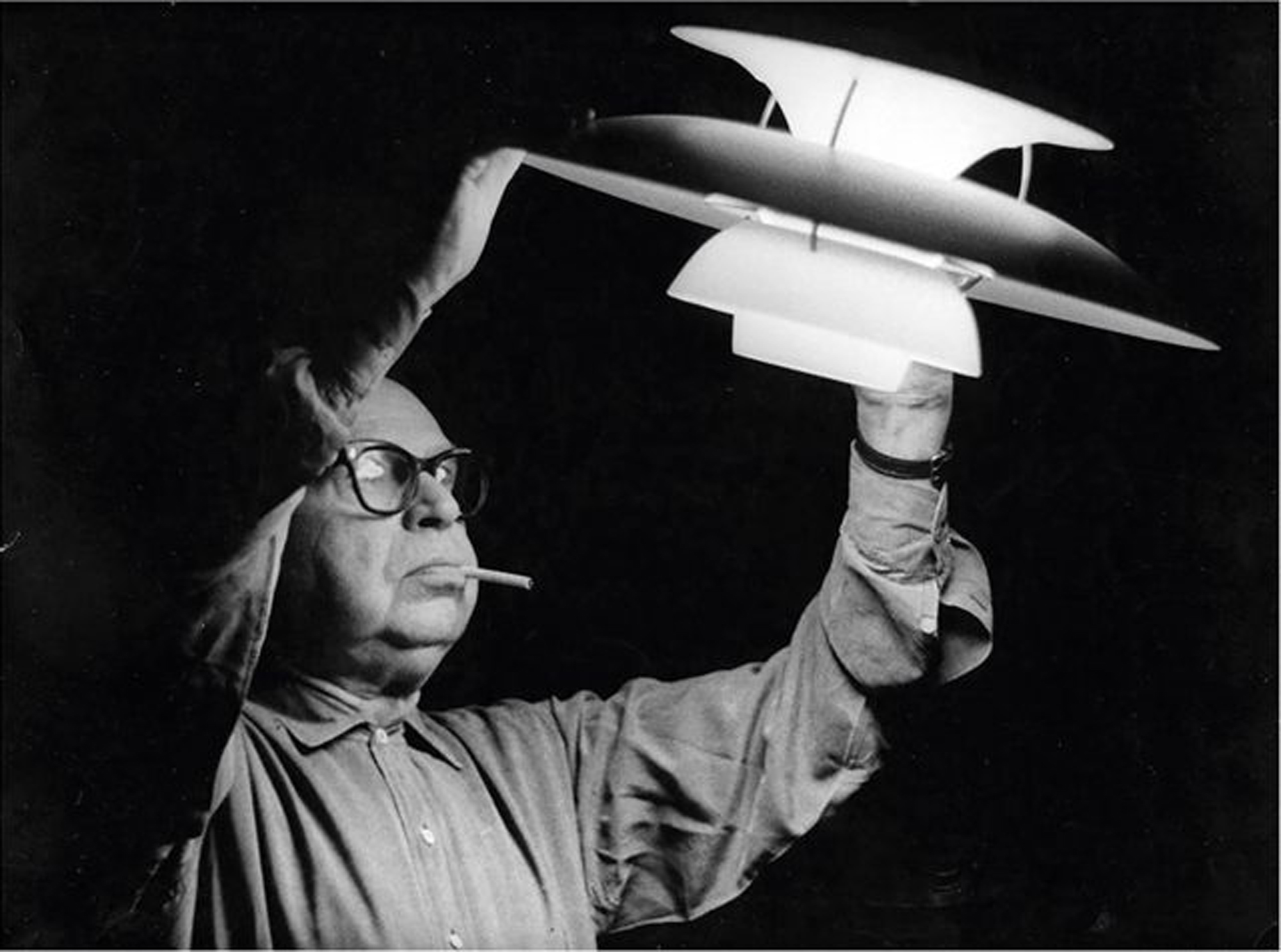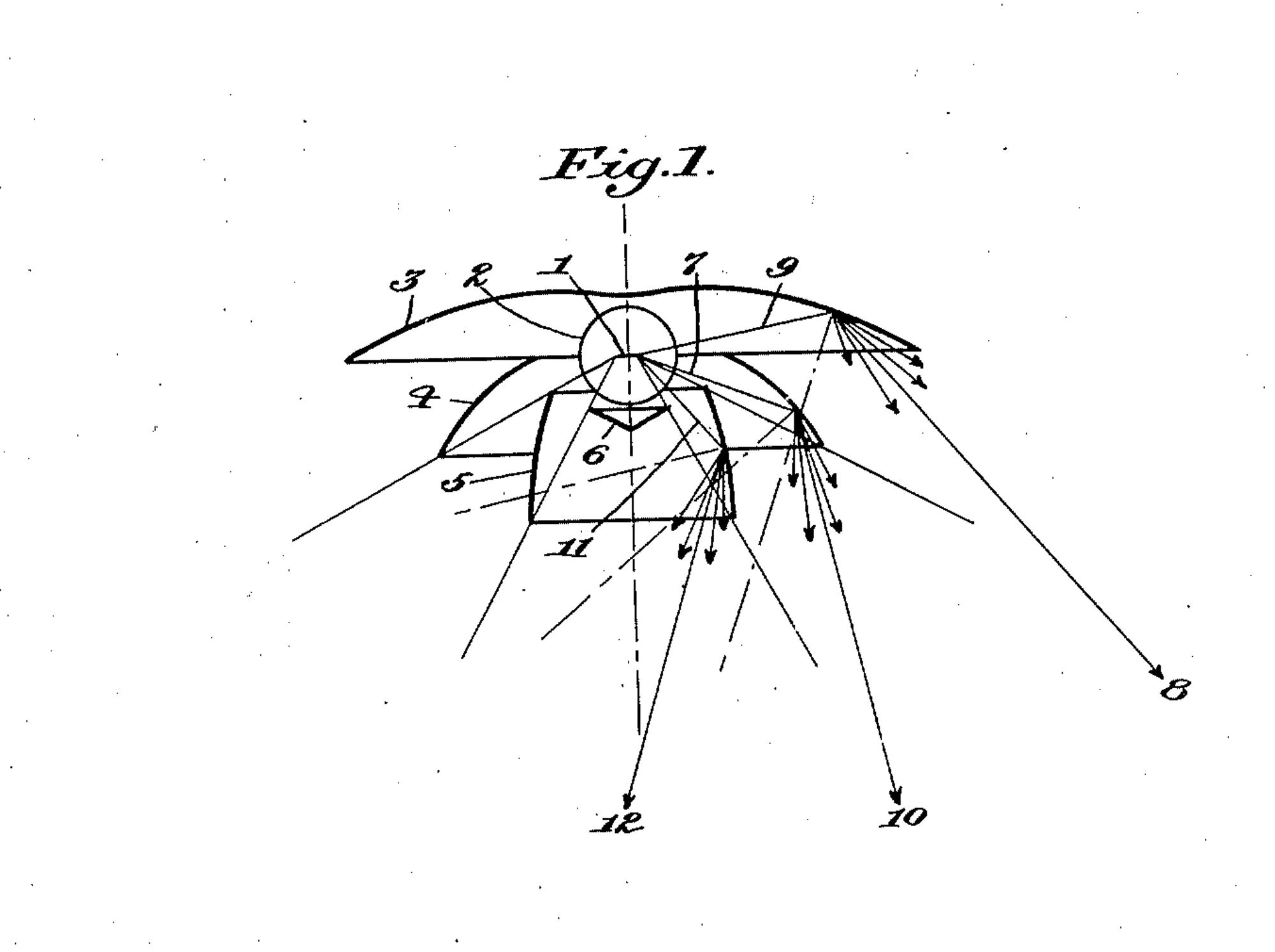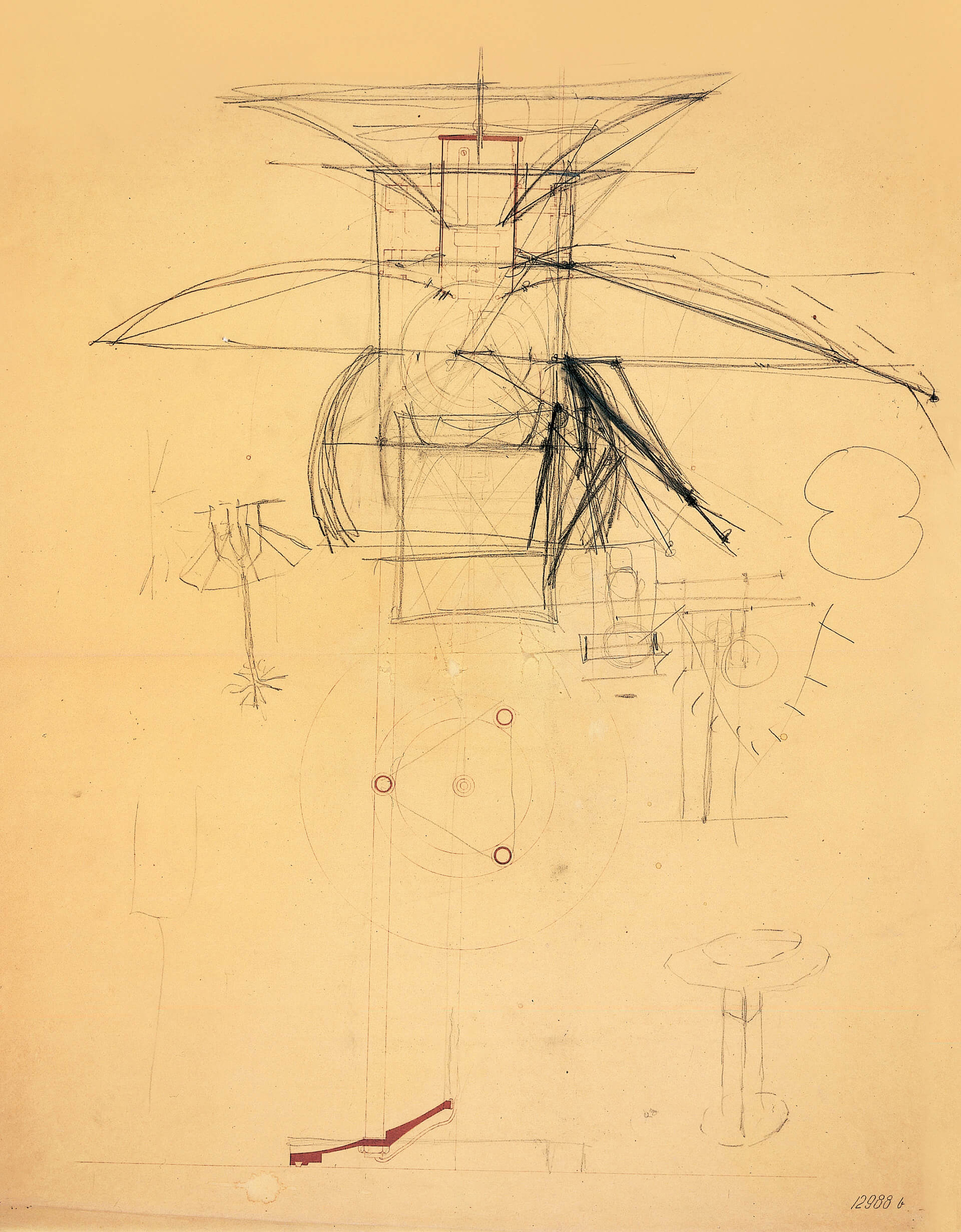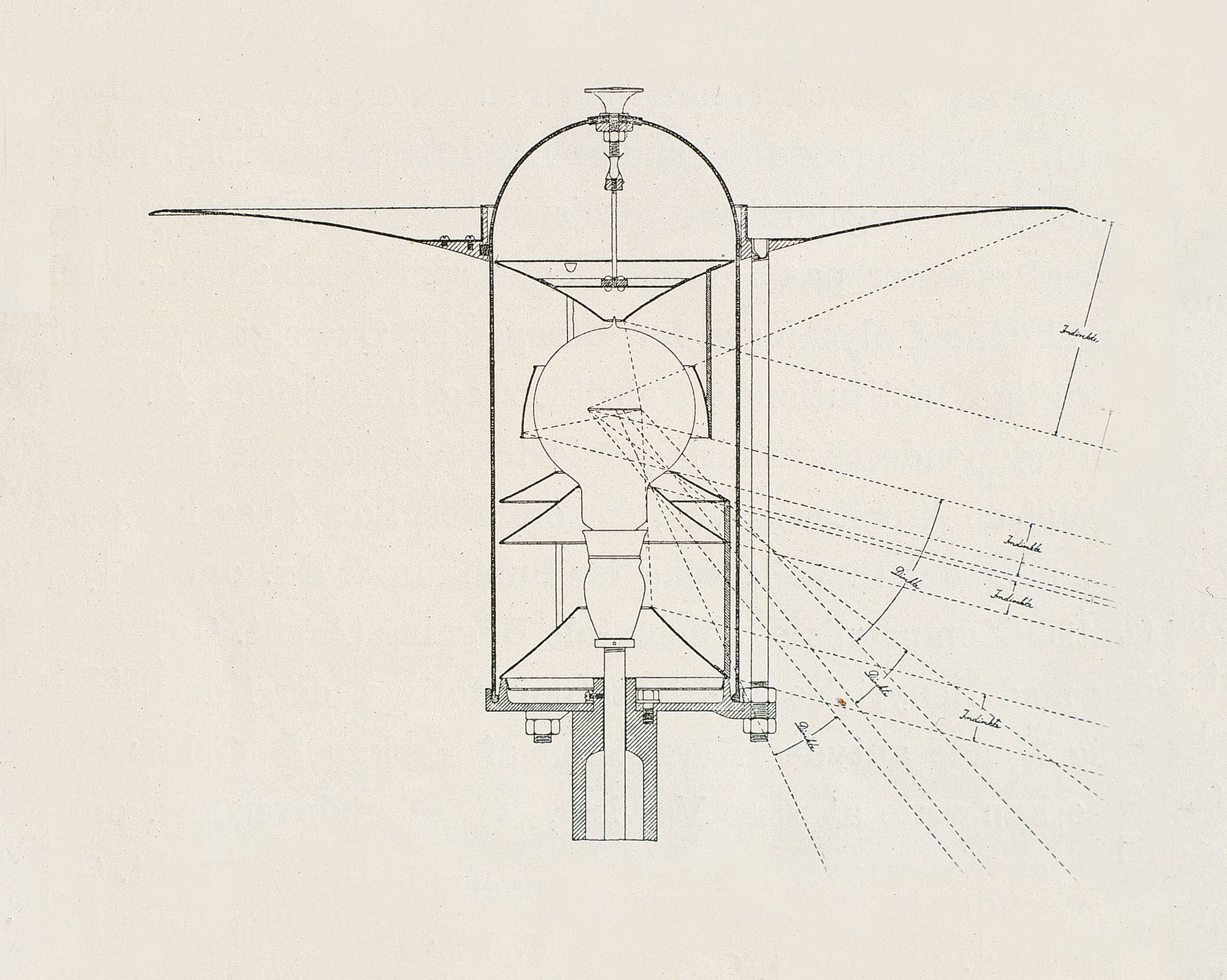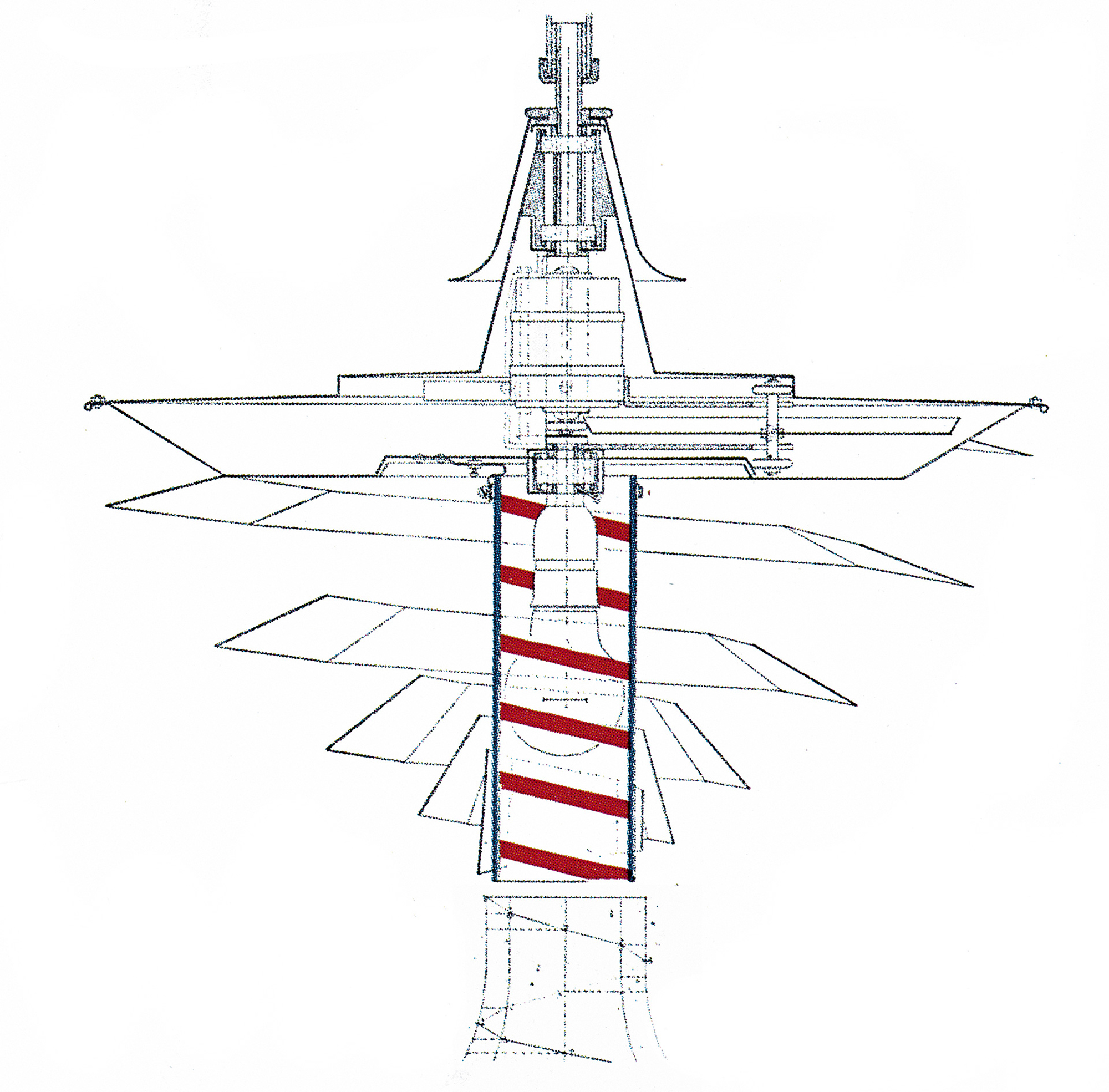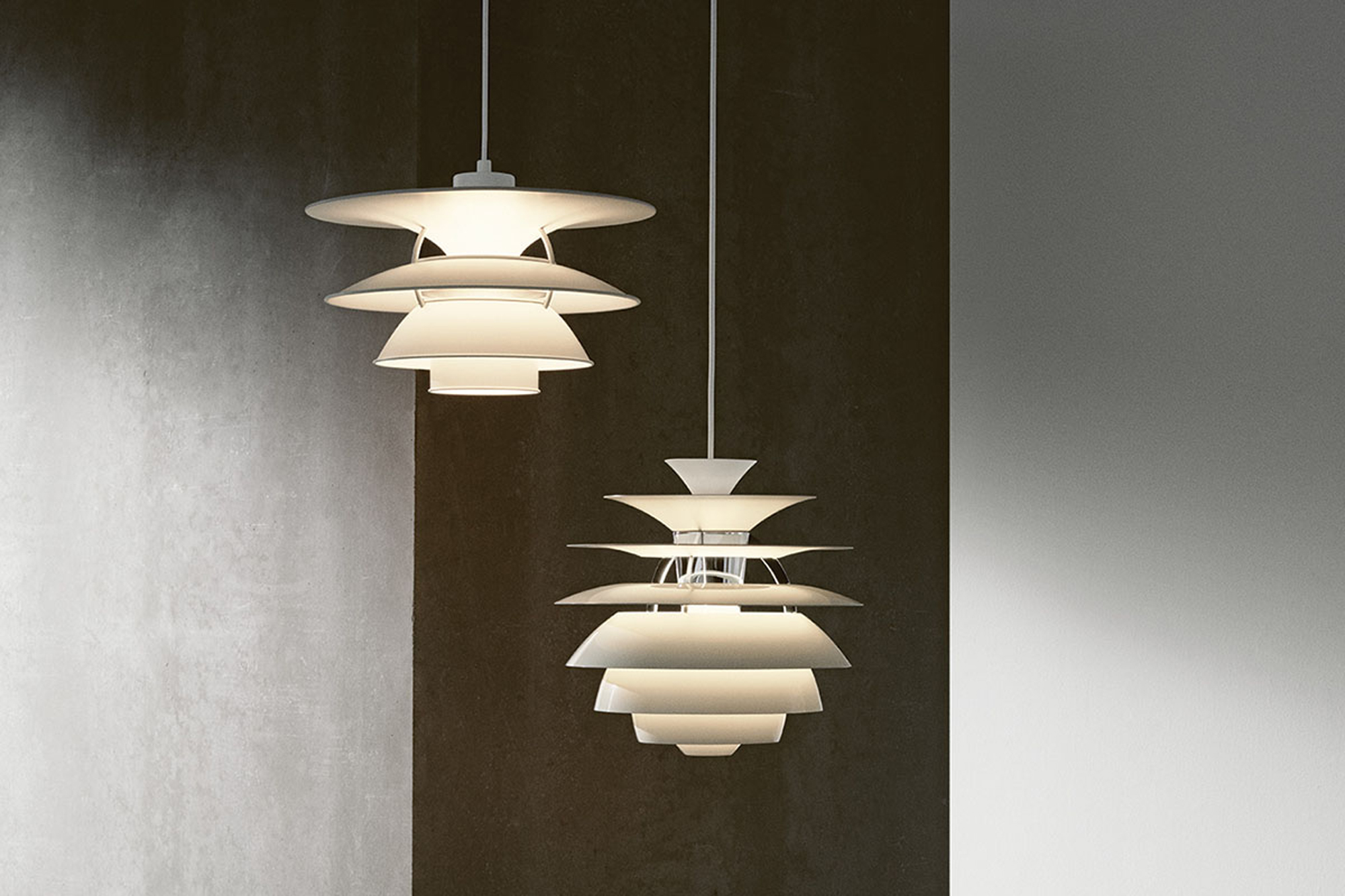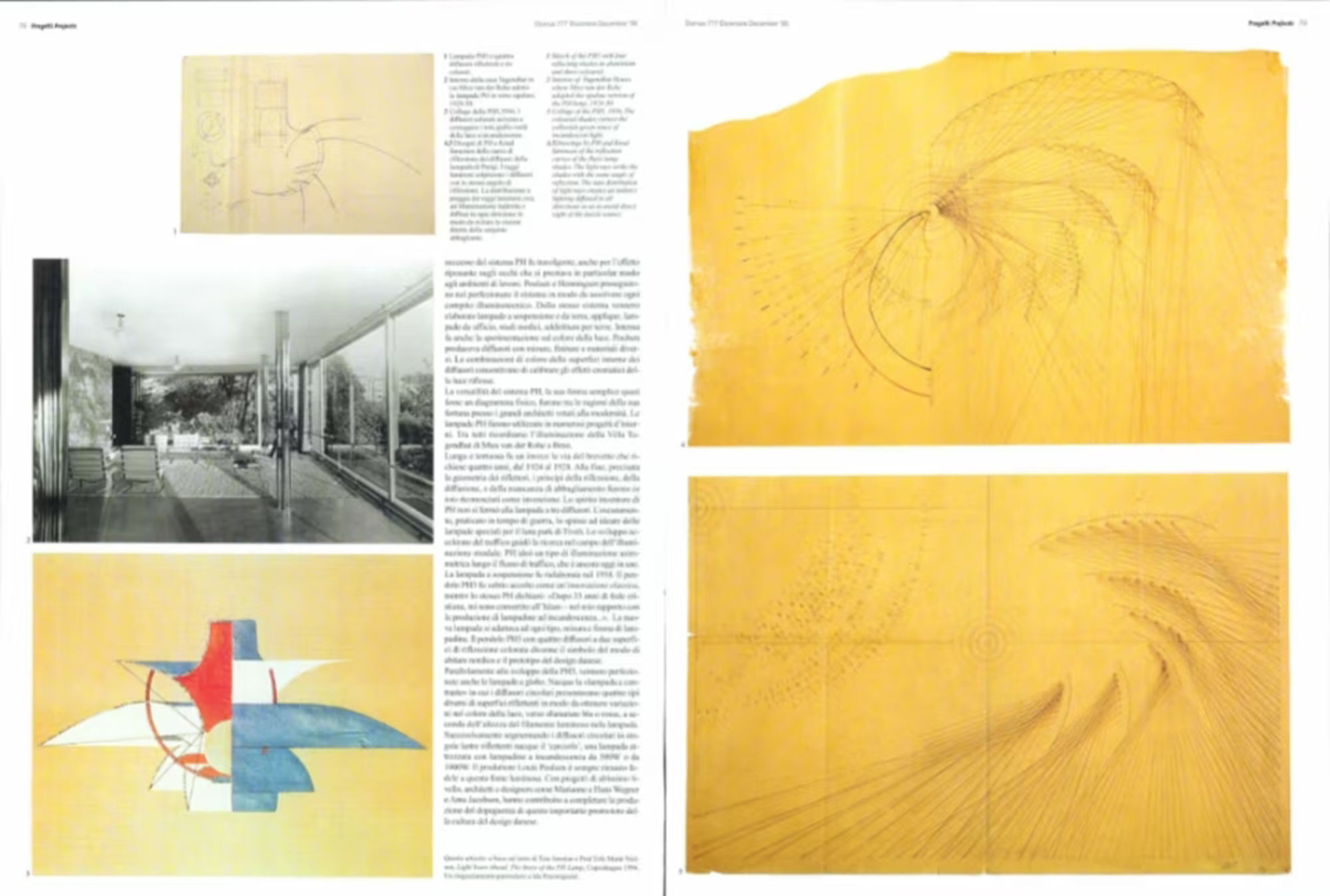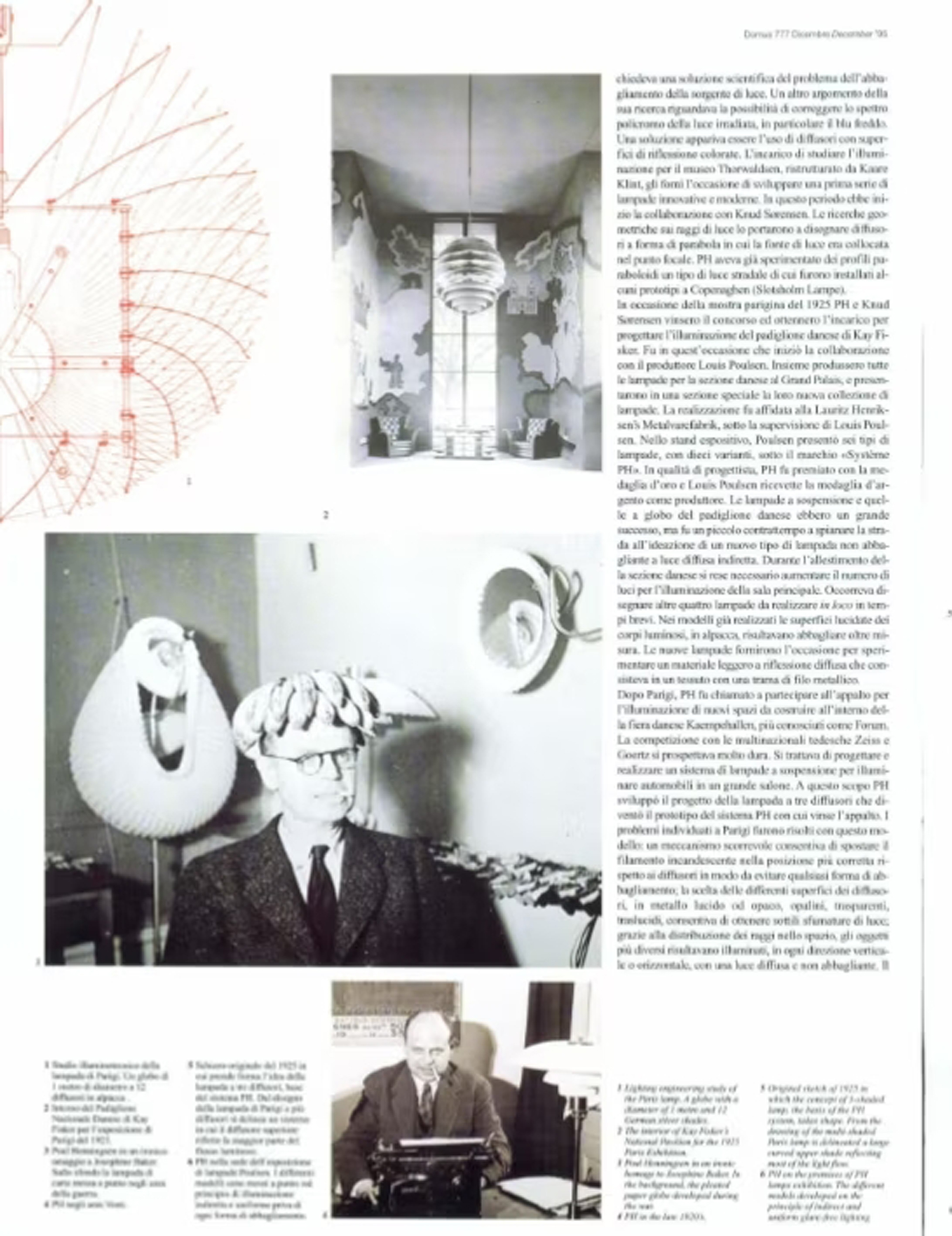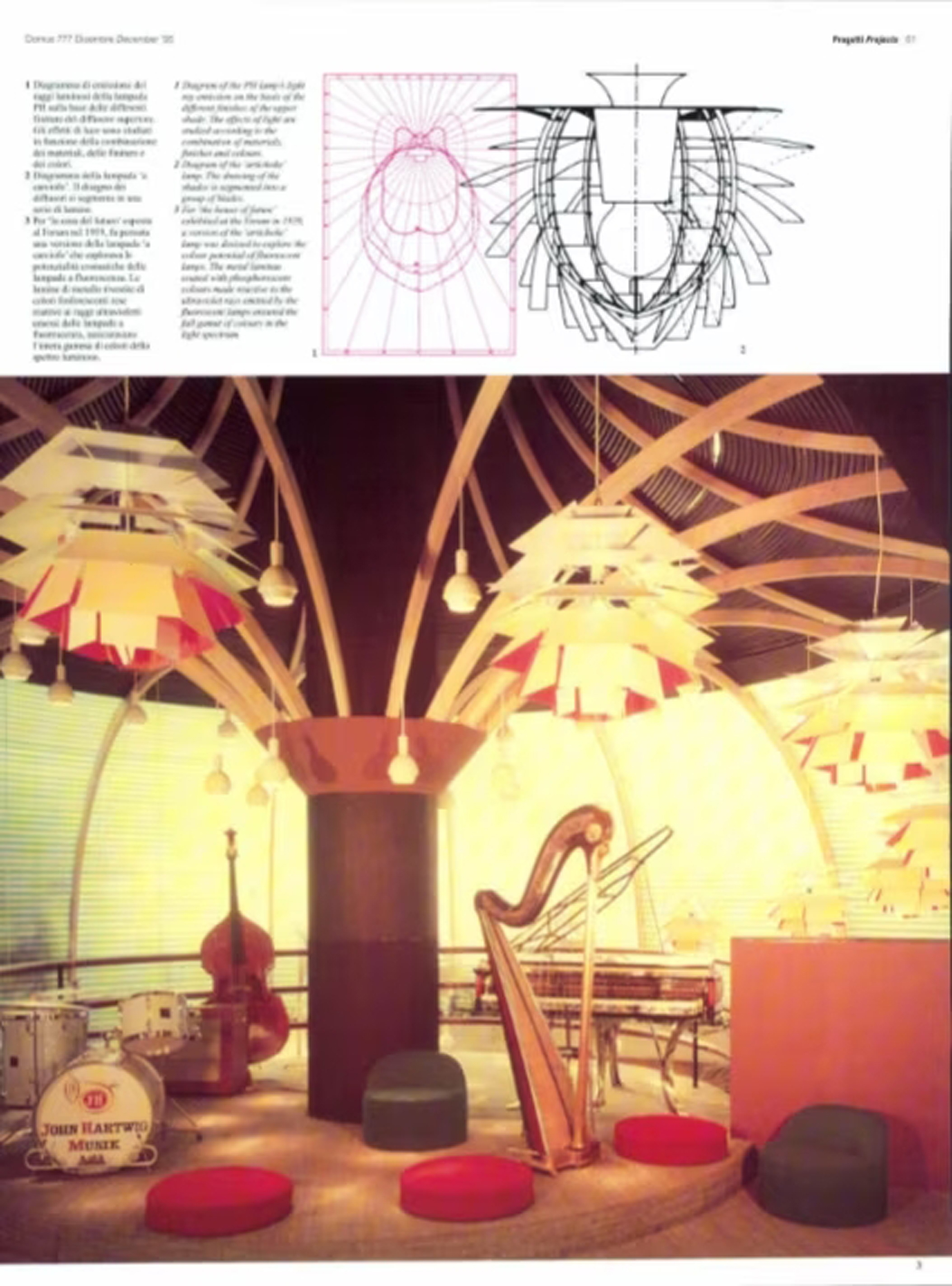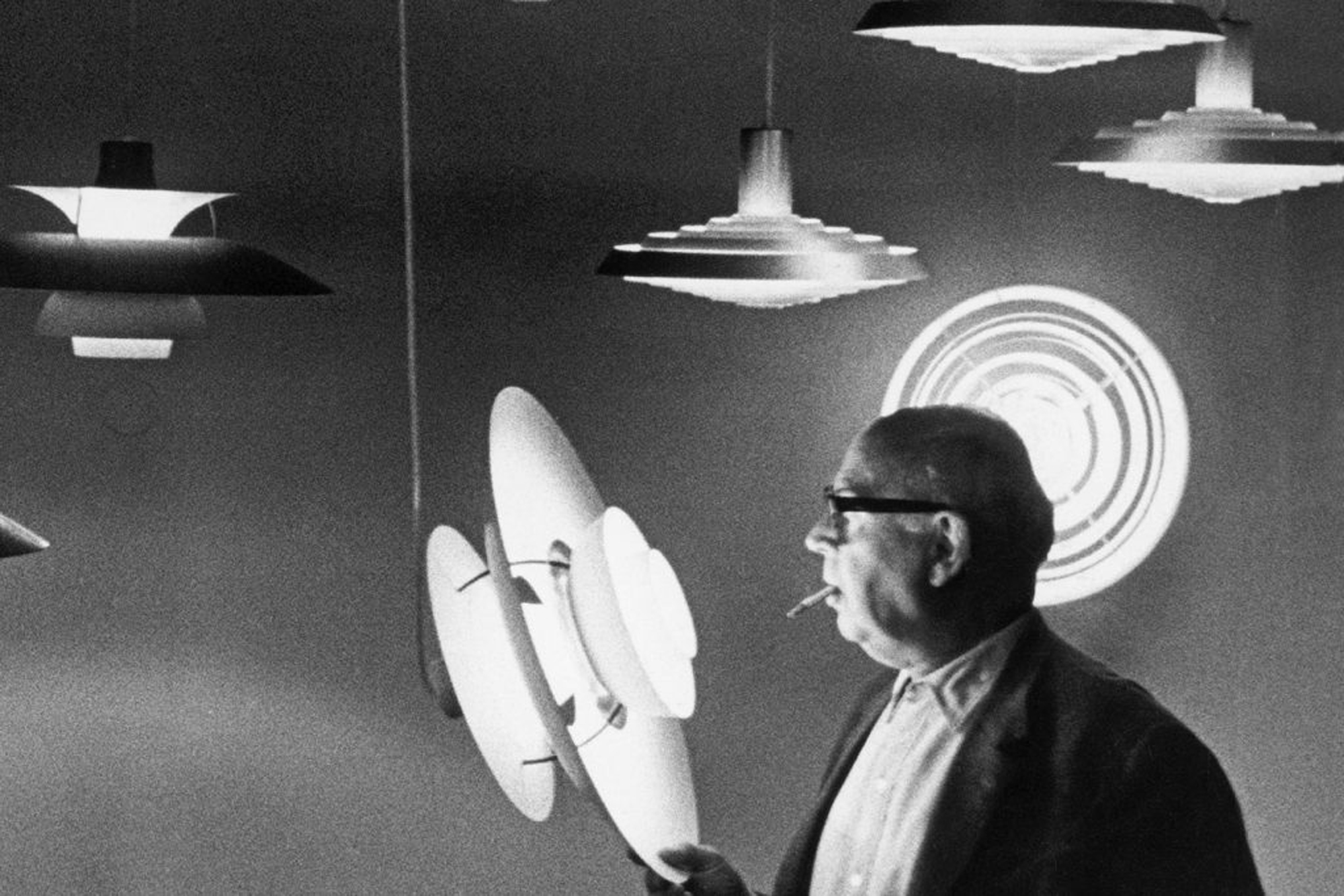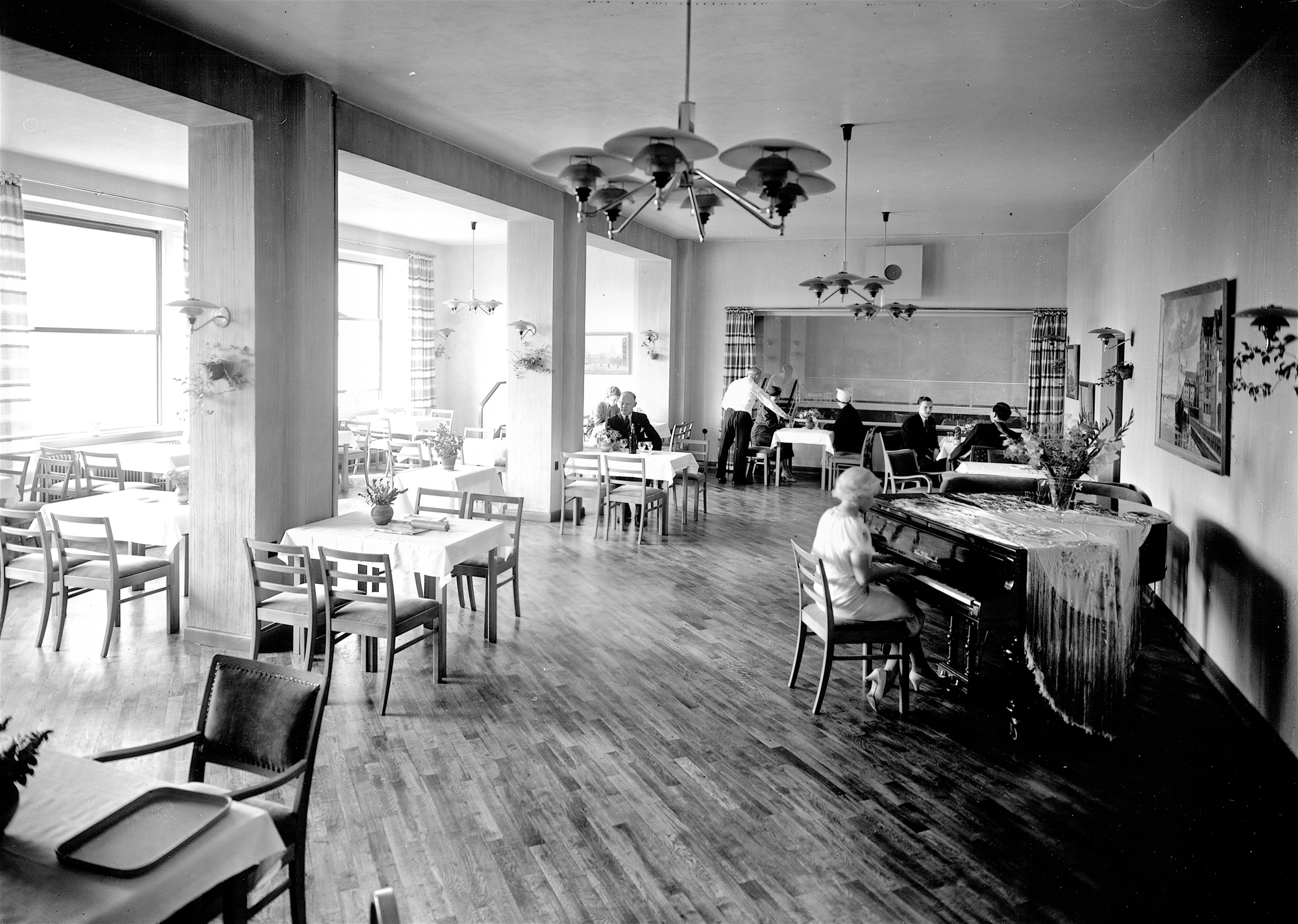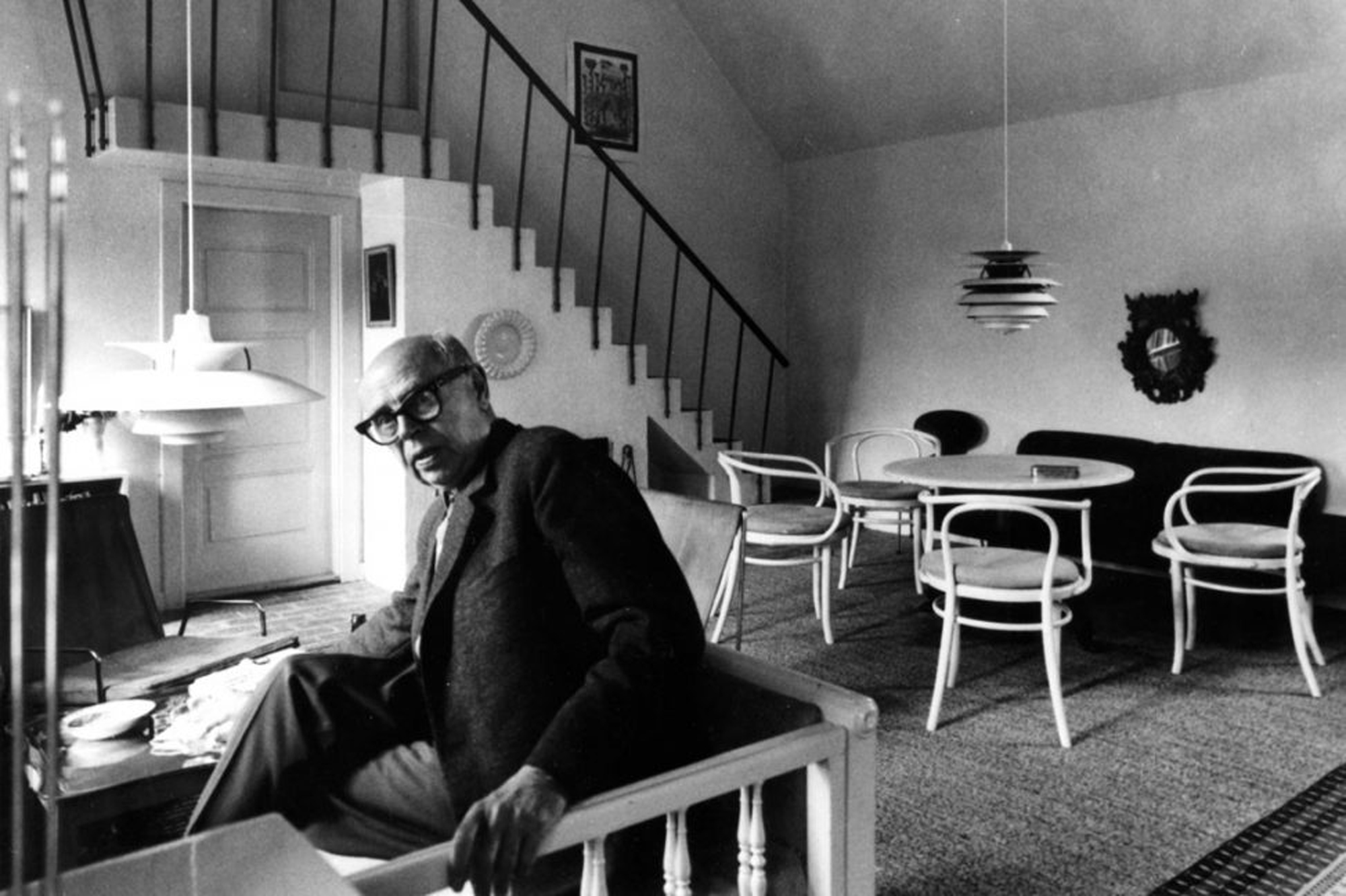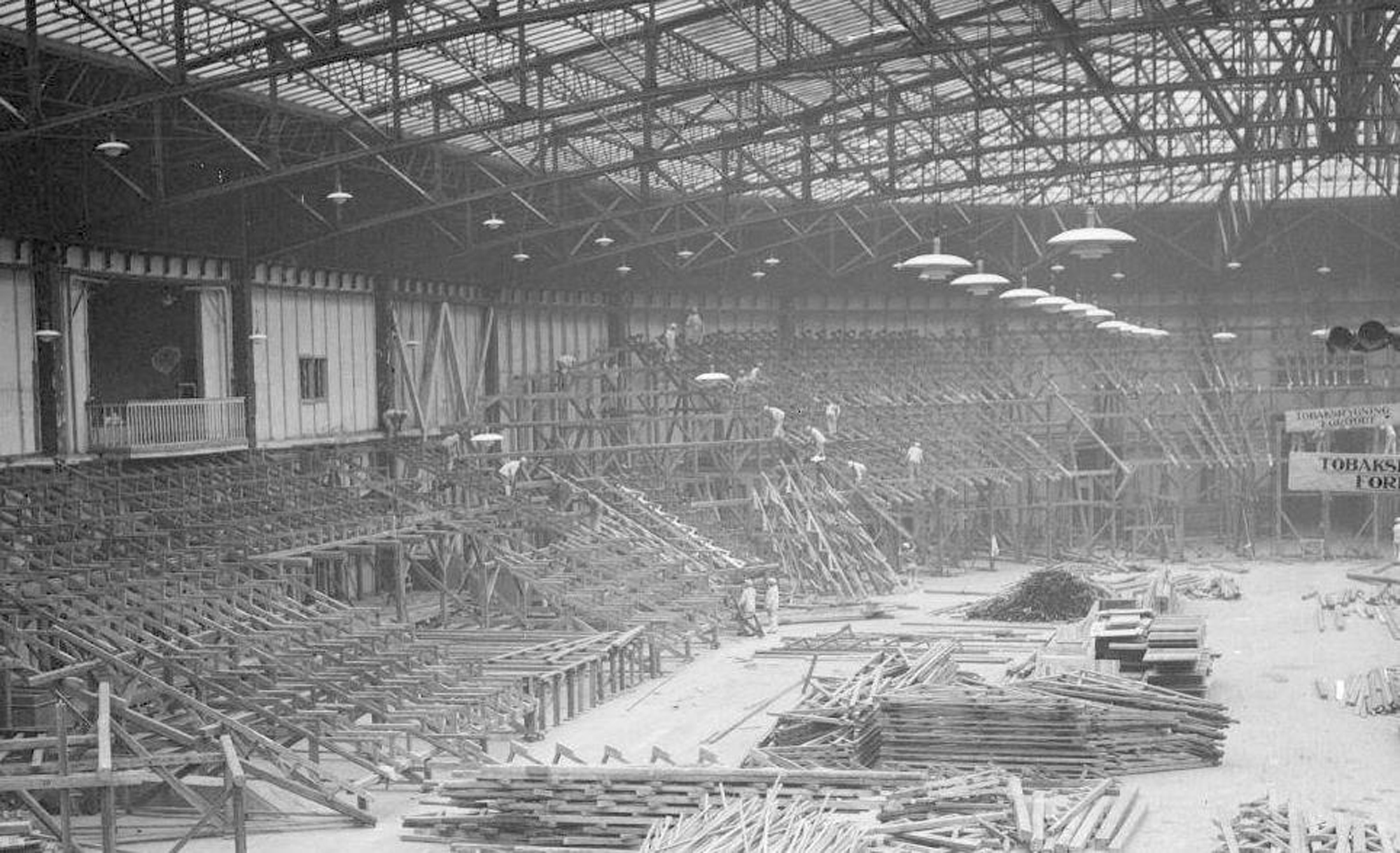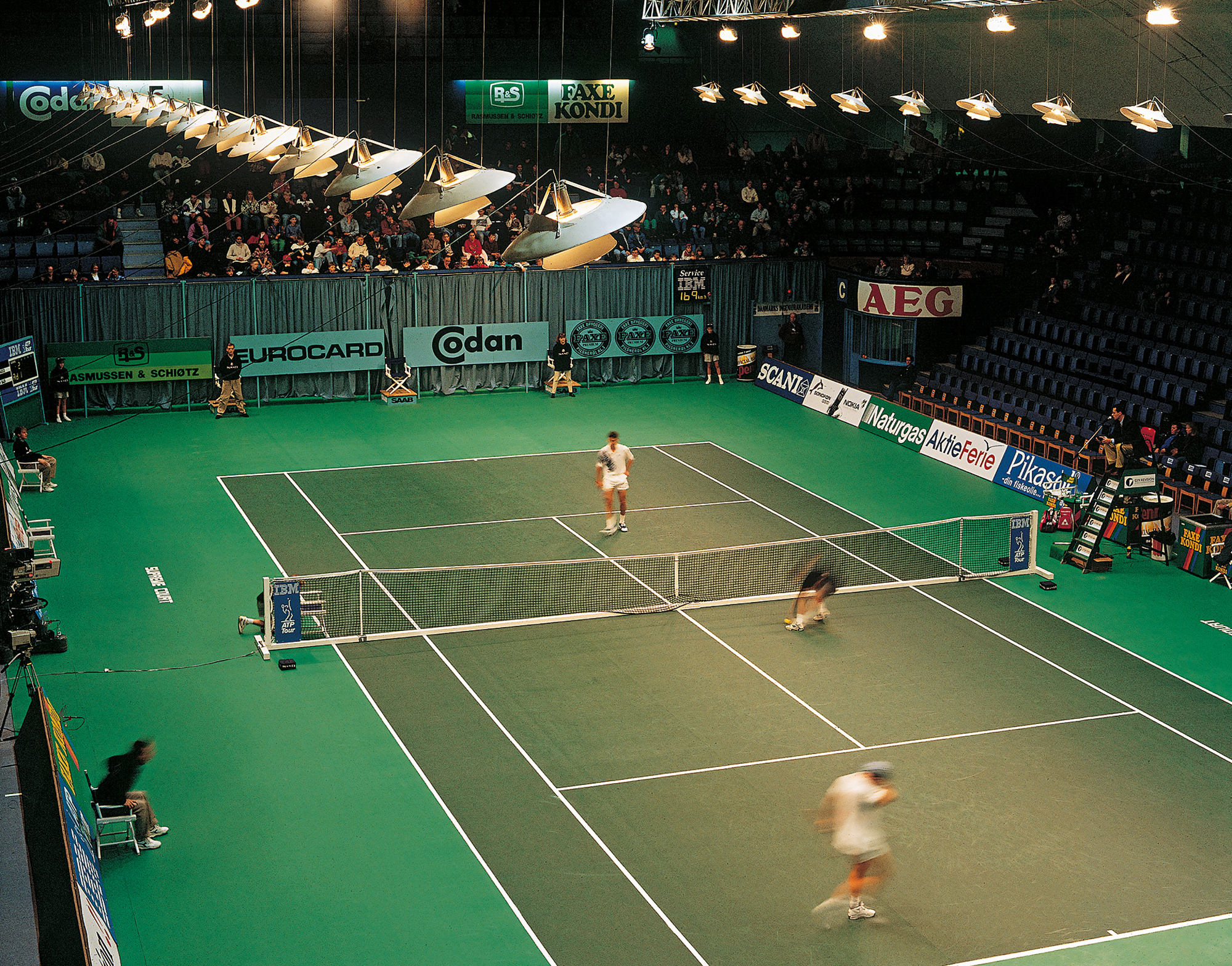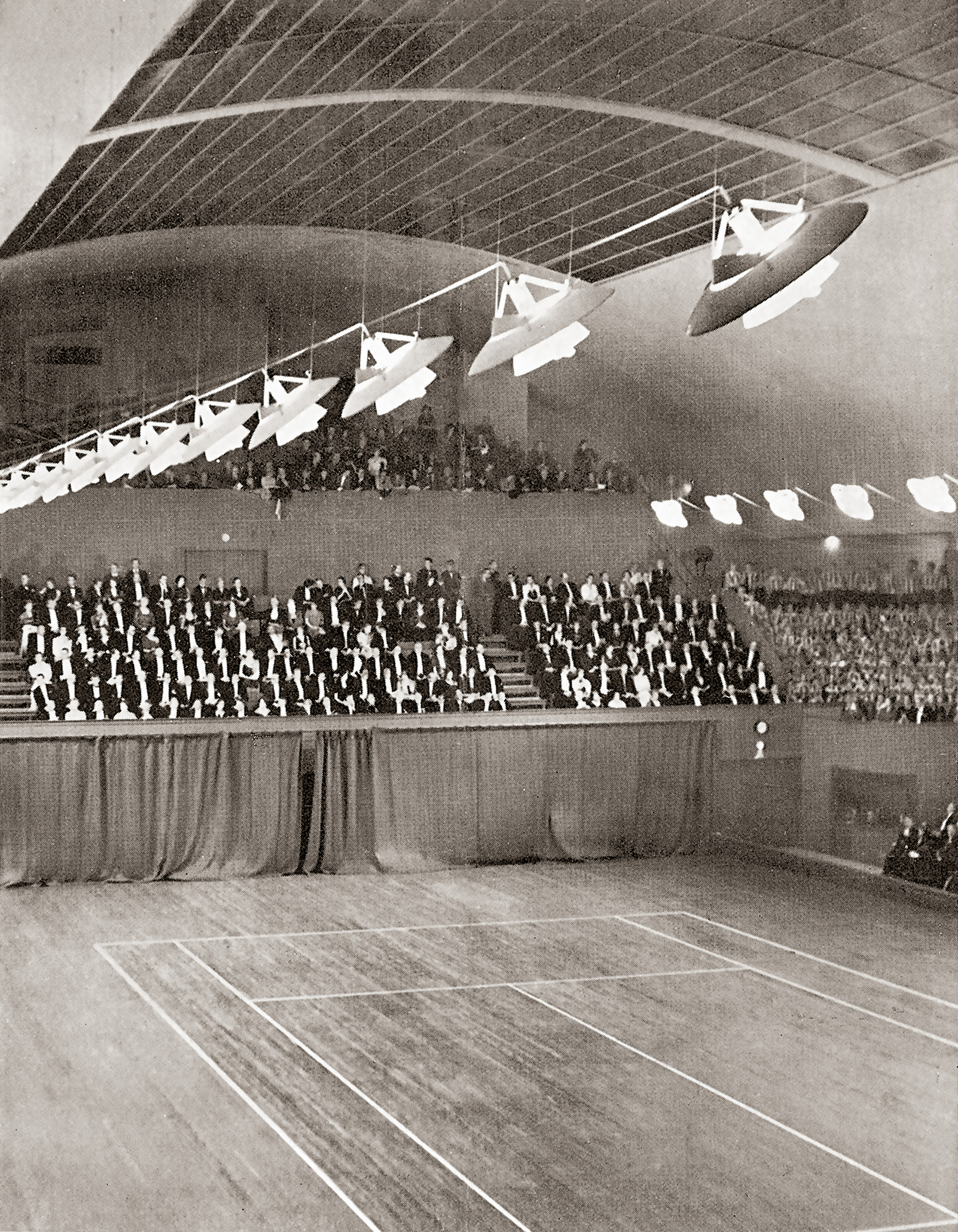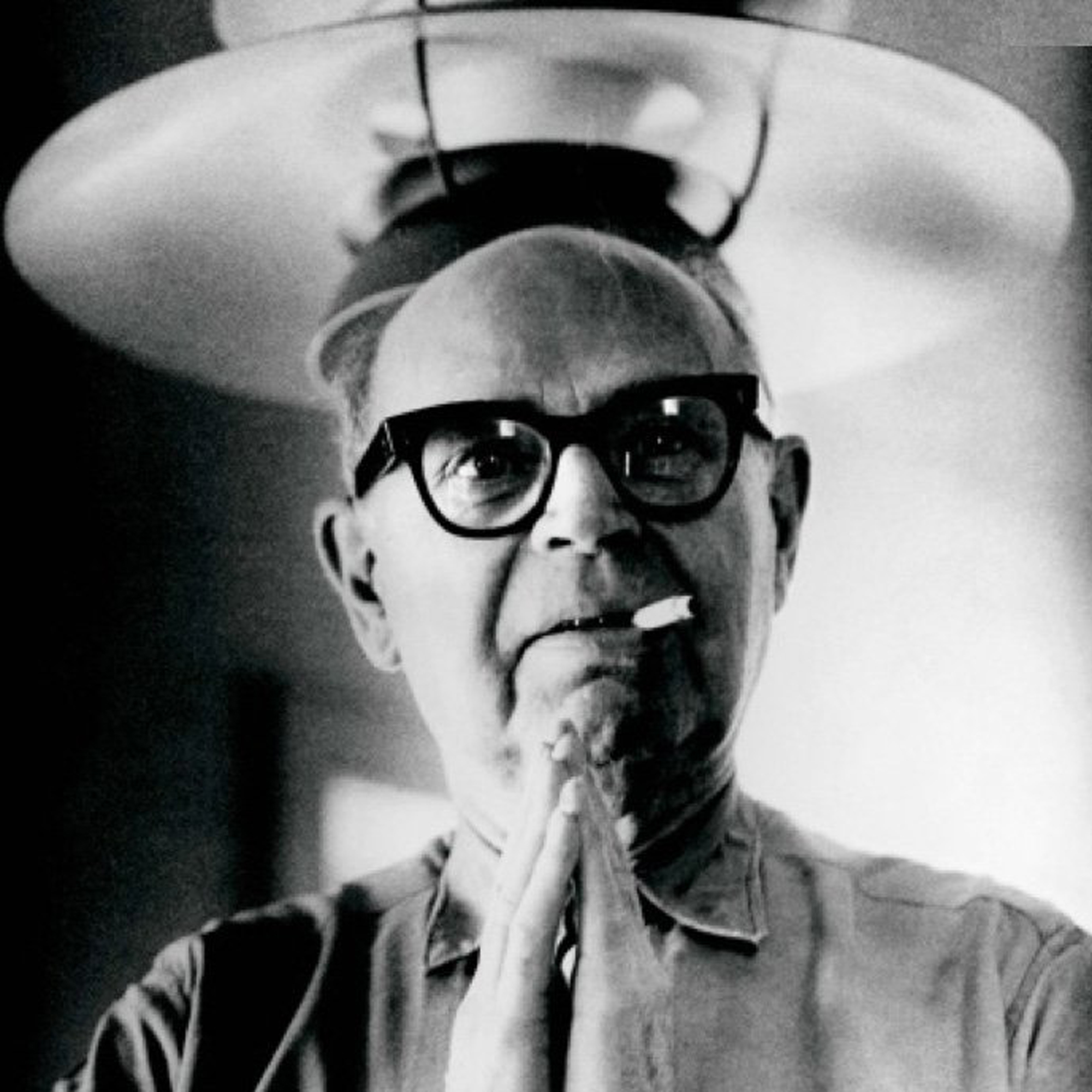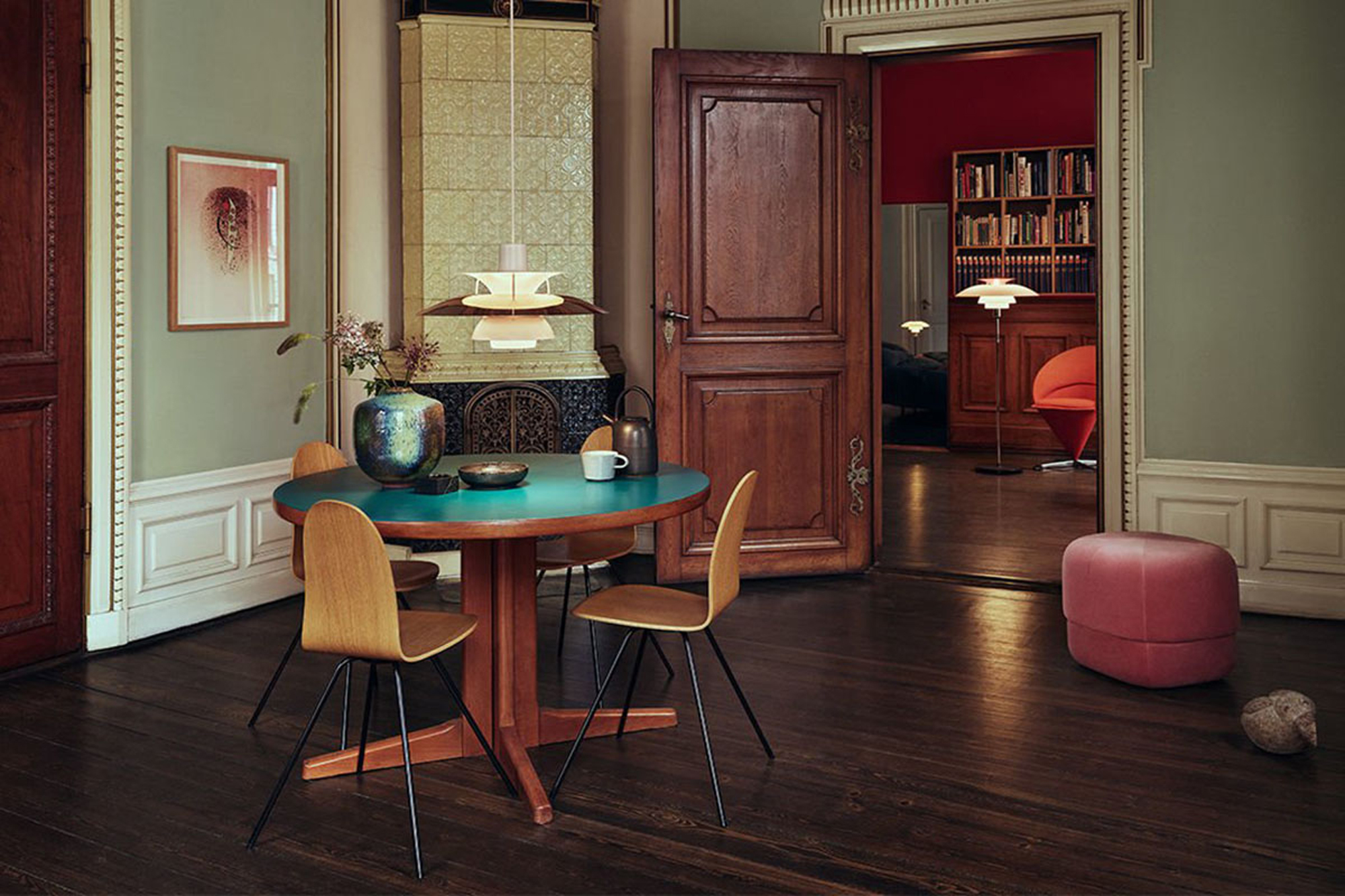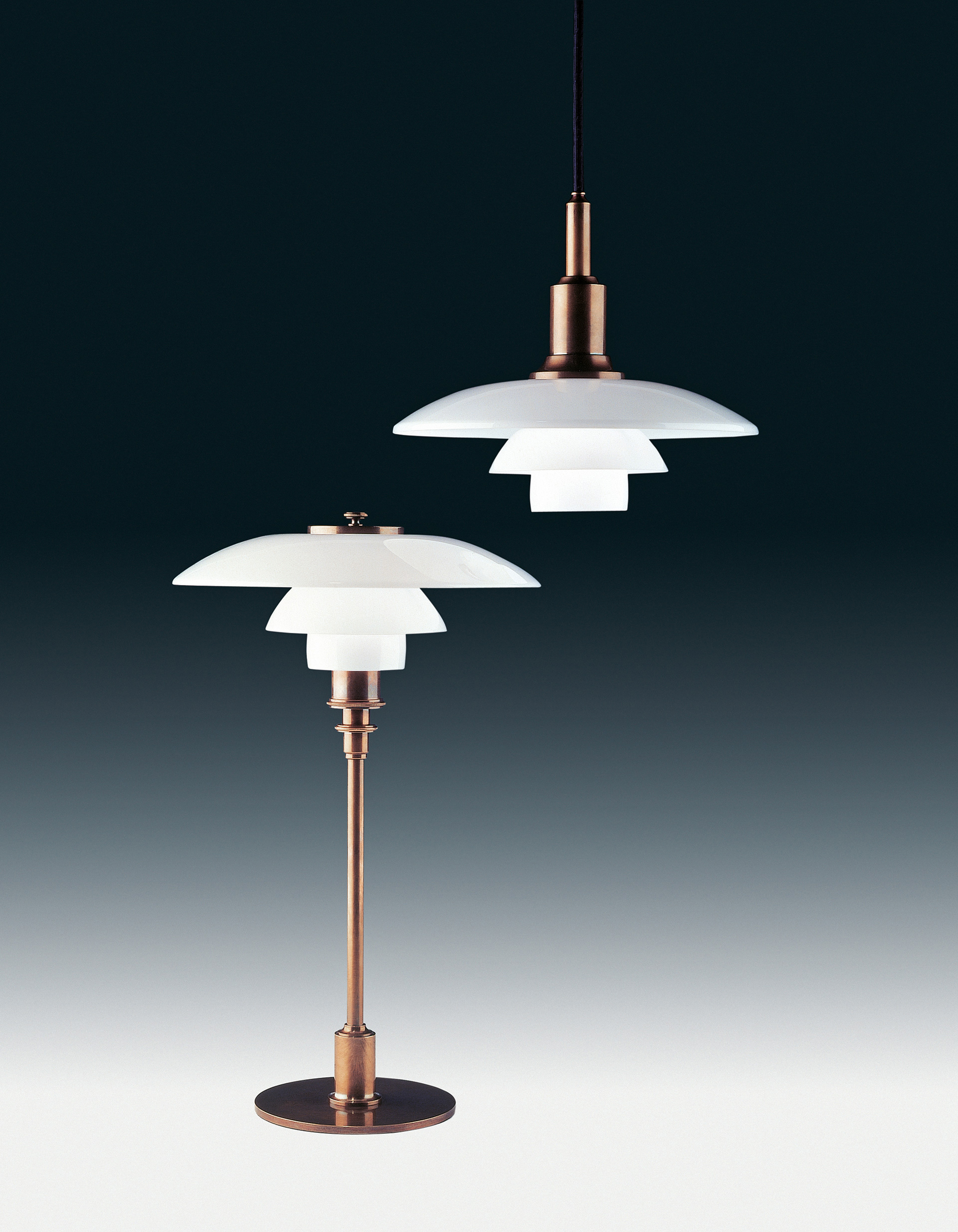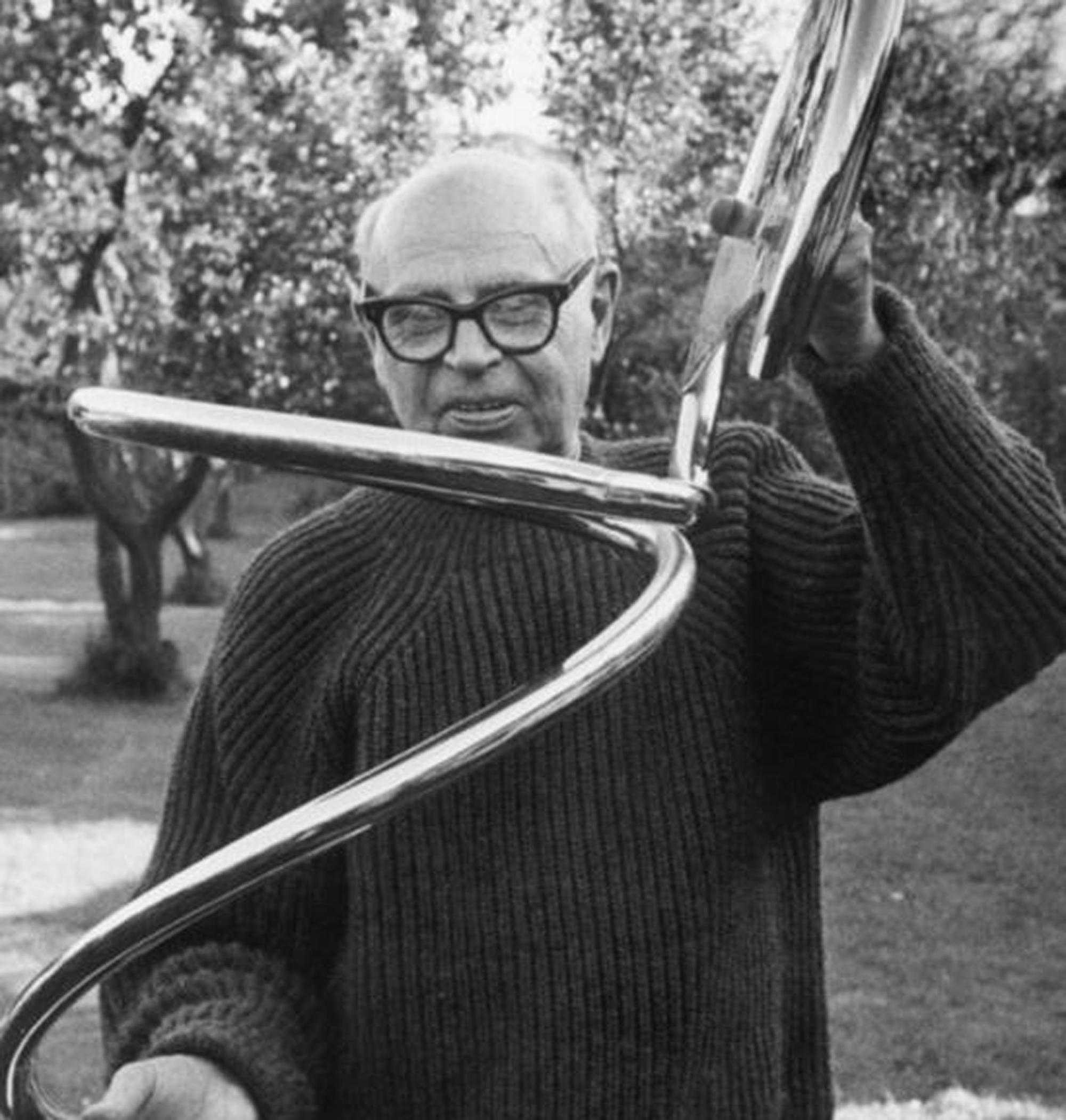
Louis Poulsen's exhibition room in Nyhavn (1939)
Poul Henningsen, born in 1894 in Copenhagen, was an architect and even in the early years of life he mixed with progressive Danish writers, musicians and artists. As a young architect, without qualifications since he had not taken his final examinations at the technical college, he soon became known for his critical articles on architecture as editor of the art journal Klingen and later of the Kritisk Revy. He started his professional career in the office of Kay Fisker and then went on to work as a freelance architect. At the beginning of the 1920s he turned his attention to interior design, in which electric light was an important design element.
His first projects still used the newform of light in the classical way. The light fittings were still closely connected to the idea of burning light, either gaslight or candlelight. Not until the designs for the Carlsberg brewery did he break away from the glass prism as a light-scattering device, creating tulip-shaped glass lampshades which can radiate the light directly and diffusely. For the artists’ exhibition in autumn 1921 he worked in conjunction with the artist Axel Salto to create a severely geometrical room lit by dustproof ceiling lights and a central spherical lamp. The lamp itself was the first attempt to use horizontal shades of chased copper to conceal the light source and to use reflection to scatter warm light throughout the room.

A collection of PH's lamps on display. Image © Haabet

"Reflector for incandescent lamps" Patent for the invention of Poul Henningsen's 3-shade lamp. Image © Poul Henningsen

Display at the Danish Architecture Centre demonstrating how the lamp reflects light. Image © DAC
Poul Henningsen, PH, describes in his later writings how the increased efficiency of the light bulb made it necessary to solve scientifically the problem of glare from the light source using geometrical and arithmetical calculations. It was very important to him to be able to make corrections to the spectrum of light radiated, in particular the cold blue. One possibility was to use different coloured planes of reflection in the light shades.
A large commission to design the light fittings for the renovation of the Thorwaldsen Museum under Kaare Klint, gave PH the opportunity to develop his first new and modern series of lamps, consisting of one ceiling and two table lamps. It was at this time that the professional collaboration between PH and Knud Sorensen began. The geometrical investigation of light rays led to elliptical lampshades in which the light was to be precisely in one focus of the ellipse. These experiments had been preceded by earlier ones with paraboloid shapes – four a Street lamp, of which a few examples were put up in Copenhagen.

Sketch of the iconic PH lamp by Poul Henningsen with Louis Poulsen. Image © Louis Poulsen

Sketch of the PH lamp. Image © Louis Poulsen

Sketch of the iconic PH Artichoke. Image © Louis Poulsen

Image © Domestico, 2024

Image © Domus 777, December 1995, 2024

Image © Domus 777, December 1995, 2024

Image © Domus 777, December 1995, 2024

Image © Domus 777, December 1995, 2024

Image © Domus 777, December 1995, 2024
The Paris Exhibition of 1925 was approaching. A competition to select participants was helt in 1924, for which PH submitted his first models. His work with the supplier Louis Poulsen began at this time. PH and Knud Sorensen together with Poulsen won, giving them the opportunity to design the lighting for Kay Fisker’s Danish Pavilion. They also supplied all the lights for the Danish section in the Grand Palais and were given a special area to exhibit their new series of lamps. They were manufactured by Lauritz Henriksen’s Metalvarenfabrik supervised by Louis Poulsen.
Six models with ten variations called “PHsystems” were presented. PH was awarded the gold medal as the designer and Poulsen a silver medal as supplier. Both the pendant lamp and the globe light in the pavilion won great acclaim but thanks to a small mishap the way was opened to an absolutely glare-free lamp which radiated and scattered light indirectly.
When the Danish section was being set up it became evident that more lights than planned were needed for the main room. Four additional lamps had to be designed in such a way that they could be produced at very short notice in Paris. They had already noticed that the polished surfaces of the lampshades of German silver dazzled mercilessly but it was impossible to make any improvements. The additional light offered the opportunity to experiment with lightweight material which would give a diffuse reflection, possibly a textile reinforced by steel wire.
After the experience in Paris the opportunity arose for PH to enter a competition to find a supplier within the Danish trade fair for the lighting of the Kaemphallen which were being built at the time (later known as the Forum). The competition was tough and it was essential to tender a lower bid than the German manufacturer Zeiss & Goertz. A special feature was the type of object to be lit – motor cars in a large hall. PH developed for this the lamp with three shades which was the prototype for the PH lamp system. It was put forward for production.
All the problems which had been recognized in Paris could be solved in this utility light. With a sliding mechanism it was possible to adjust the height of the fil ament to achieve the right geometrical relationship to the shades and avoid or correct any glare, the choices of different surfaces for the lampshades – shiny or matt metallic, glassy, transparent, etched glass or milk glass – made a range of subtle nuances in the light possible and the scattering angle of the light rays in the room made it possible to light very different objects ranging from horizontal to vertical surfaces with absolutely glare-free, diffuse light.
The success of the PH system was overwhelming and the physiological benefit of these lamps, particularly in work spaces, was recognized. Poulsen and PH remained active, making the system so precise that any lighting task could be fulfilled. Pendant lamps, wall lamps, floor lamps, lights for workplaces, for doctors and even for greenhouses could be included in the same series. They worked particularly intensively on colours of light. Poulsen supplied shades which were not only of different sizes, materials and surfaces but could also reflect the light using different nuances of colour, so that, according to the particular requirements of an application, shades of colour could be corrected using the inner reflecting surface of the lamp.
The versatility of the PH system, but also its form, which was so self-evident it might have been developed from a diagram explaining a phenomenon of physics, contributed to its widespread use by modern architects. The culmination was their use to light all the main rooms in the Tugendhat Villa in Brno designed by Mies van der Rohe.


Academy Crown lamp in Copenhagen restaurant (1937)

Image © Domestico, 2024

Langeline Pavilion, 1880's. Image © Louis Poulsen

Construction of bicycle races path at the first Forum building (before it was destroyed in 1943). Image © Unknown

An indoor stadium with PH lamps installed. Image © Louis Poulsen

An indoor stadium with PH lamps installed. Image © Louis Poulsen

Poul Henningsens PH-Lampe von 1925. Image © Holger Ellgaard

Image © Domestico, 2024

Image © Domestico, 2024

Spiral Lamps at Aarhus University

The PH Artichoke designed by Poul Henningsen and manufactured by Louis Poulsen. Image © Lars Kaslov

Sketch of the PH lamp by Louis Poulsen. Image © Louis Poulsen

Poul Henningsen's Snake Stool
But the patenting of the lamps took a long time, a total of four years from 1924 to 1928. Only with the help of studies by various professors they managed to find the right wording for the patent. The principles of reflection, scattering and glare-free light in combination were recognized as being an extraordinary achievement. But PH’s inventor mentality did not stop with the three-shaded lamp. Wartime with the typical phenomenon of blackout brought about the development of tested models for the Tivoli Amusement Park.
The rapid increase in traffic also stimulated further research into street lighting and once more PH broke new ground with a proposal for a symmetrical lighting in the direction of the traffic flow, a system which incidentally is still in use today. The pendant lamp was modernized in 1958. When the PH5 pendant lamp was presented it was hailed as a “classical innovation”, in PH’s own words: “After 33 years of faith in Christianity I have converted to Islam when it comes to the manufacture of electric lights”. PH developed the new lamp for every type of light bulb in every possible size and shape. The PH5 with four shades and two coloured reflecting areas became the epitome of Nordic lifestyle and became the showpiece of Danish design. PH did not live to see the development of the energy saving light: he died in 1967.
In 1995 Louis Poulsen presented the PH pendant with an energy-saving facility. The globe lights were developed in parallel to the PH5. Coloured reflection fans were added to the circular shades. According to how the height of the light bulb in the lamp was adjusted the light was corrected with blue or red: the contrasting light. The round shades were broken down into individual reflectors which is how the eccentric “artichoke” came into being which can be fitted with a 500 W or 1000 W bulb. Louis Poulsen always remained loyal to the light bulb and after the war the modern architects Marianne and Hans Wegner and Arne Jacobsen added high-calibre designs to enhance the production range of this important promoter of Danish design culture.
